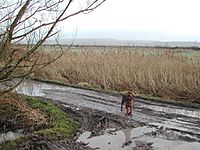Puxton Moor facts for kids
| Site of Special Scientific Interest | |
 |
|
| Area of Search | Avon |
|---|---|
| Coordinates | 51°21′47″N 2°50′45″W / 51.36301°N 2.84595°W |
| Interest | Biological |
| Area | 31.07 hectares (0.3107 km2; 0.1200 sq mi) |
| Notification | 1994 |
Puxton Moor is a very special nature area in North Somerset, England. It covers about 31 hectares, which is like 76 football fields! This land is mostly grassy fields with many small waterways called 'rhynes'.
Because of its unique plants and animals, Puxton Moor was made a Site of Special Scientific Interest (SSSI) in 1994. This means it's a place with very important nature that needs to be protected. The Avon Wildlife Trust now owns and manages this area as a nature reserve.
Discovering Puxton Moor
Puxton Moor is a flat area found on the North Somerset Levels. It's a great example of how old farming land can still be home to amazing wildlife. The 'rhynes' are like small ditches or canals that crisscross the fields. They are super important for the plants and animals living here.
Amazing Animals and Plants
The rhynes at Puxton Moor are home to some rare plants. You might spot frogbit, which looks like tiny water lilies. There's also rootless duckweed, a very small plant that floats on the water without roots.
Many interesting insects also live in these waterways. Keep an eye out for the hairy dragonfly and the water scorpion. These creatures are not easy to find in other places!
Birds love Puxton Moor too. You might hear the beautiful song of the skylark flying high above. Other birds seen here include reed and sedge warblers, Eurasian whimbrel, whitethroat, and reed bunting.
A Look into the Past
Puxton Moor isn't just important for nature; it also holds clues about history! If you look closely, you can still see signs of an old Roman landscape. This shows how the land was used and divided thousands of years ago.
There are also Medieval earthworks present. These are old bumps and hollows in the ground that were created during the Middle Ages. They tell us about how people lived and worked on this land long, long ago.

